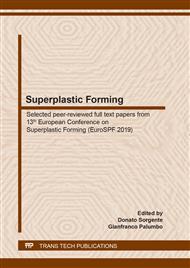[1]
T.G. Langdon, Seventy-five years of superplasticity: historic developments and new opportunities, J. Mater. Sci. 44 (2009) 5998-6010.
DOI: 10.1007/s10853-009-3780-5
Google Scholar
[2]
G.D. Bengough, A study of the properties of alloys at high temperatures, J. Inst. Metals 7 (1912) 123-178.
Google Scholar
[3]
C.H.M. Jenkins, Strength of Cd-Zn and Sn-Pb alloy solder, J. Inst. Metals 40 (1928) 21-32.
Google Scholar
[4]
C.E. Pearson, The viscous properties of extruded eutectic alloys of lead-tin and bismuth-tin, J. Inst. Metals 54 (1934) 111-124.
Google Scholar
[5]
D.A. Woodford, Strain-rate sensitivity as a measure of ductility, Trans. ASM 62 (1969) 291-293.
Google Scholar
[6]
T.G. Langdon, A unified approach to grain boundary sliding in creep and superplasticity, Acta Metall. Mater. 42 (1994) 2437-2443.
DOI: 10.1016/0956-7151(94)90322-0
Google Scholar
[7]
T.G. Langdon, Identifying creep mechanisms in plastic flow, Z. Metallkd. 96 (2005) 522-531.
Google Scholar
[8]
A.J. Barnes, Superplastic forming 40 years and still growing, J. Mater. Eng. Perform. 16 (2007) 440-454.
DOI: 10.1007/s11665-007-9076-5
Google Scholar
[9]
E.M. Taleff, G.A. Henshall, T.G. Nieh, D.R. Lesuer, J. Wadsworth, Warm-temperature tensile ductility in Al-Mg alloys, Metall. Mater. Trans. A 29A (1998) 1081-1091.
DOI: 10.1007/s11661-998-1017-x
Google Scholar
[10]
P.E. Krajewski, J.G. Schroth, Overview of quick plastic forming technology, Mater. Sci. Forum 551-552 (2007) 3-12.
DOI: 10.4028/www.scientific.net/msf.551-552.3
Google Scholar
[11]
H. Ishikawa, F.A. Mohamed, T.G. Langdon, The influence of strain rate on ductility in the superplastic Zn-22% Al eutectoid, Phil. Mag. 32 (1975) 1269-1271.
DOI: 10.1080/14786437508228105
Google Scholar
[12]
T.G. Langdon, The physics of superplastic deformation, Mater. Sci. Eng. A137 (1991) 1-11.
Google Scholar
[13]
R.Z. Valiev, O.A. Kaibyshev, R.I. Kuznetsov, R.Sh. Musalimov, N.K. Tsenev, Low-temperature superplasticity of metallic materials, Dokl. Akad. Nauk SSSR 301 (1988) 864-866.
Google Scholar
[14]
C. Xu, M. Furukawa, Z. Horita, T.G. Langdon, Achieving a superplastic forming capability through severe plastic deformation, Adv. Eng. Mater. 5 (2003) 359-364.
DOI: 10.1002/adem.200310075
Google Scholar
[15]
T.G. Langdon, Twenty-five years of ultrafine-grained materials: Achieving exceptional properties through grain refinement, Acta Mater. 61 (2013) 7035-7059.
DOI: 10.1016/j.actamat.2013.08.018
Google Scholar
[16]
R.Z. Valiev, D.A. Salimonenko, N.K. Tsenev, P.B. Berbon, T.G. Langdon, Observations of high strain rate superplasticity in commercial aluminum alloys with ultrafine grain sizes, Scripta Mater. 37 (1997) 1945-1950.
DOI: 10.1016/s1359-6462(97)00387-4
Google Scholar
[17]
R.B. Figueiredo, T.G. Langdon, Record superplastic ductility in a magnesium alloy processed by equal-channel angular pressing, Adv. Eng. Mater. 10 (2008) 37-40.
DOI: 10.1002/adem.200700315
Google Scholar
[18]
S. Lee, A. Utsunomiya, H. Akamatsu, K. Neishi, M. Furukawa, Z. Horita, T.G. Langdon, Influence of scandium and zirconium on grain stability and superplastic ductilities in ultrafine-grained Al-Mg alloys, Acta Mater. 50 (2002) 553-564.
DOI: 10.1016/s1359-6454(01)00368-8
Google Scholar
[19]
H. Akamatsu, T. Fujinami, Z. Horita, T.G. Langdon, Influence of rolling on the superplastic behavior of an Al-Mg-Sc alloy after ECAP, Scripta Mater. 44 (2001) 759-764.
DOI: 10.1016/s1359-6462(00)00666-7
Google Scholar
[20]
Z. Horita, M. Furukawa, M. Nemoto, A.J. Barnes, T.G. Langdon, Superplastic forming at high strain rates after severe plastic deformation, Acta Mater. 48 (2000) 3633-3640.
DOI: 10.1016/s1359-6454(00)00182-8
Google Scholar
[21]
P.H.R. Pereira, Y. Huang, M. Kawasaki, T.G. Langdon, An examination of the superplastic characteristics of Al-Mg-Sc alloys after processing, J. Mater. Res. 32 (2017) 4541-4553.
DOI: 10.1557/jmr.2017.286
Google Scholar
[22]
M. Kawasaki, T.G. Langdon, The contribution of severe plastic deformation to research on superplasticity, Mater. Trans. 60 (2019) 1123-1130.
DOI: 10.2320/matertrans.mf201915
Google Scholar


